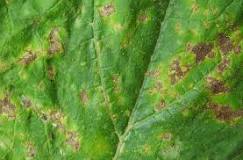DOWNY MILDEW


Downy mildew is a disease of the foliage, caused by a fungus-like (Oomycete) organism. It is spread from plant to plant by airborne spores. It is a disease of wet weather as infection is favored by prolonged leaf wetness.
DISEASE SYMPTOMS:
Downy mildew causes light green to yellow angular spots on the upper surfaces of leaves. The white fluffy growth of the pathogen develops on the lower sides of these spots. With time these lesions turn brown and dry up. Older leaves are attacked first. Severely infected leaves may die
Small purplish brown spots on under surface of leaves
In cabbage, these spots expose the heads to soft rot
Stems show dark brown and depressed lesions or streaks which later develop downy growth of fungus.
HOST PLANTS:
Downy mildews infect almost all ornamental plants as well as some indoor plants. Greenhouse crops reported to have downy mildew diseases include snapdragon, Salvia, alyssum, pansy, sunflower, rosemary, Primula, Osteospermum, Impatiens walleriana, coleus, statice, Verbena, ornamental cabbage, basil, Broccoli, Sorghum and Cucurbits etc.
SURVIVAL AND SPREAD:
Primary: Oospores in infected plant debris or in soil
Secondary: Wind borne and rain splashed sporangia
FAVOURABLE CONDITION:
Moderate temperatures (60° to 80°F) and shady conditions generally are the most favorable for powdery mildew development. Spores and fungal growth are sensitive to extreme heat (above 90°F) and direct sunlight.
Neutral to acidic soils, pH 5-7.
CONTROL:
Chlorothalonil and mancozeb are the main protectant fungicides for downy mildew.
Copper fungicides and sulfur have also been used.





